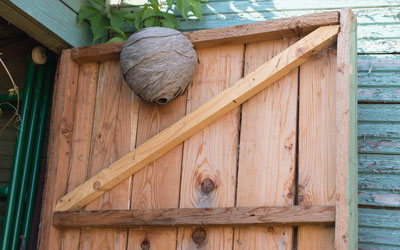
The team at Western Exterminator, formerly Pratt Pest is here to provide you with the information you need to know to help identify wasp nests.
4 Common Wasp Nests
Paper wasps, mud daubers, yellowjackets, and bald-faced hornets are the main kinds of wasps we’ll see here in the Snohomish area. Here’s what to know about these nests:
- Paper wasps
- A paper wasp nest often looks like an upside-down umbrella.
- These nests tend to be more open, and can get quite large in size.
- They are typically supported by a single stalk and made out of a papery substance.
- Nests can be located under and within the eaves of structures, in attics and wall voids, and in other enclosed areas.
- Mud daubers
- Female wasps construct their nests out of mud.
- The nests are small and tubular in size, often looking like organ pipes.
- They are typically found in cracks or crevices.
- Tend to build their nests in sheltered areas, including under eaves, garages, attics, or on the sides of buildings.
- Yellowjackets
- Nests are a papery material and have a single opening.
- The inside of a yellowjacket nest can have up to 100 tiers of cells.
- Yellowjackets can also build underground nests that can be enormous in size.
- Favor areas near the ground, in hollow trees, under porches, and a number of other areas.
- Bald-faced hornets
- These nests are almost always at least three feet off the ground.
- They are made of chewed wood fibers mixed with saliva.
- They can grow to the size of a football or basketball.
- Builds its nest oftentimes in trees, bushes, or wooded areas, but they also can be on buildings.
What to Do About a Wasp Nest
If you see any of the above wasp nests forming on or near your property, it’s important to take caution and stay away. Certain wasps can get very aggressive when it comes to defending their nests. Even worse, many are inclined to sting repeatedly—needless to say, this can become very dangerous. If you have a wasp nest nearby, always contact the professional wasp control experts at Western.
